Saints of the Day
 |
 |
 |
 |
 |
 |
 |
St. Joseph of Leonissa - February 4
Biographical selection:
He was a member of the Order of the Friars Minor Capuchin. His relic is venerated in our chapel. He lived in the 16th century.
Comments of Dr. Plinio:
Unfortunately I have no other biographical data on St. Joseph Leonissa. We received a theca with relics of all Capuchin Saints as a gift from Prof. Fernando Furquim, who brought it from Rome. Since we normally make a mention of the Saints whose relics are in our chapel, here is a reference to St. Joseph of Leonissa.
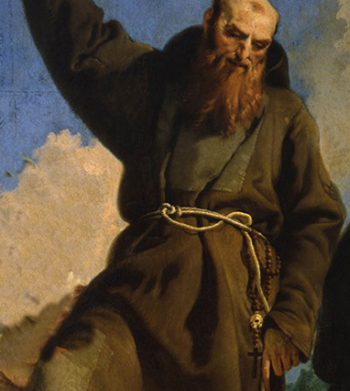 You may ask: Why this reference, given that we only have what seems to be a circumstantial link with this Saint? It is because the "just circumstantial" does not exist in these matters. If Divine Providence wanted his relic to be in our chapel, It has a design for this Saint to protect us.
You may ask: Why this reference, given that we only have what seems to be a circumstantial link with this Saint? It is because the "just circumstantial" does not exist in these matters. If Divine Providence wanted his relic to be in our chapel, It has a design for this Saint to protect us.
Who was this Saint? What did he do during his life? In what way did he give glory to God?
Our answer is an act of faith. We know that he was a Saint and therefore he did excellent things. We do not know in which way he gave glory to God, even though we know that he gave glory to God since Holy Mother Church has declared him a Saint.
We only know one thing about St. Joseph of Leonissa from this brief selection, and it suffices: He was a Capuchin Saint.
What does it mean to be a Capuchin Saint? What are the traits that marked the Capuchins in History? What is the message for a Catholic soul when it learns that Joseph of Leonissa was a Capuchin Saint?
We know that the Franciscan Order is one of the major spiritual families born in the Church from the zeal of an incomparable man, St. Francis of Assisi. He had such a love for Our Lord that he acquired a physical similarity with Our Lord. If a person were to look at St. Francis he might think that he was seeing Our Lord.
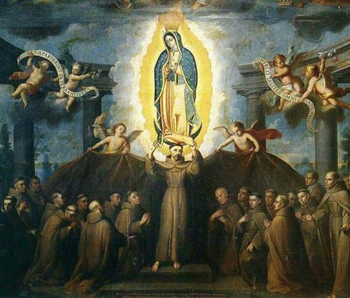 The Franciscan Order produced a waterfall of saints and good works in all the fields of the Church's activity until this tremendous crisis in which we are today. The Franciscan Order was strongly proved by sin and by the Devil. Soon after St. Francis' life, divisions appeared in the Order interpreting his spirituality in different ways.
The Franciscan Order produced a waterfall of saints and good works in all the fields of the Church's activity until this tremendous crisis in which we are today. The Franciscan Order was strongly proved by sin and by the Devil. Soon after St. Francis' life, divisions appeared in the Order interpreting his spirituality in different ways.
From this plurality of interpretations many branches were born within the Franciscan Order, approved by the Church. One of them was the Capuchin Order.
At the moment the spirit of St. Francis was weakened in other branches of the Franciscans, the Capuchin Order represented the radicalism of its poverty. It represented the radicalism of that great independence that only poverty gives.
Today one judges that only a wealthy man is independent. In the time that the Capuchins came into being, it was known that, with wealth came many concerns, attachments, duties and need for protection. Therefore, wealth attaches man to earth and poverty actually raises man above earthly concerns.
A poor man has fewer obligations, fewer goods to defend; he lives trusting Divine Providence. One who does not have anything has nothing to fear, so to speak. One who needs very little is the most independent man that exists. The Capuchin friar represented this independent man.
He was not independent regarding his superiors and the Catholic Church – to which he was bound by the vow of obedience – but he was independent regarding the powers of the world.
The Capuchin was by definition the audacious preacher who spoke the entire truth. He would speak the truth as a confessor and as a preacher to all the great men of this world, be they the great Prelates of the Church or the prestigious heads of the State.
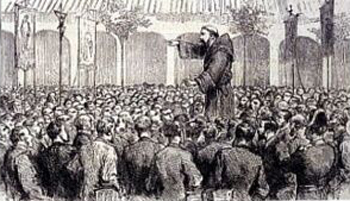 The typical Capuchin is a man from the people, stocky, with an easy speech, with sufficient religious culture although not too deep, with a continuous contact with the soul of the people, with a serenity of soul that made him able to deal as an equal not only with the little people, but with those who were great according to the world, including kings.
The typical Capuchin is a man from the people, stocky, with an easy speech, with sufficient religious culture although not too deep, with a continuous contact with the soul of the people, with a serenity of soul that made him able to deal as an equal not only with the little people, but with those who were great according to the world, including kings.
He knew that he was a priest and a religious and, because of this, he was more than everyone. The fact that he spoke the truth to all made the Capuchin the type of célèbre preacher who was invited to preach in the courts. He ascended to the pulpit causing shockwaves by the poverty of his habit, by the rope he wore at the waist – his only ornament – which represented obedience since with it the superior could drag him wherever he desired.
He had a beard, at a time when elegant men had well-kept, refined and perfumed beards with delicate moustaches, the big spontaneous Capuchin had a shocky beard that covered his whole chest. His tonsure was prominent and disfigured his head, giving a jolt to the beauty of the well-groomed hair styles adopted by the hidalgos. All these characteristics represented his renouncement of everything to which people could be attached.
In the confessional the Capuchin was the direct, precise, crystalline confessor, unafraid to give severe penances, unmindful of what others would say about his rigor. He would spend hours in the confessional resolving the problems of persons. The Capuchin was the proper expression of the perfect confessor. A lion against the sin and a lamb toward the sinner, he would energetically rip the souls from the Devil's claws and lead them to Heaven.
This profile of the Capuchin entered History as one the riches of the Church, one of the splendors of the Church, one of the magnificent types through which the Holy Spirit makes His work.
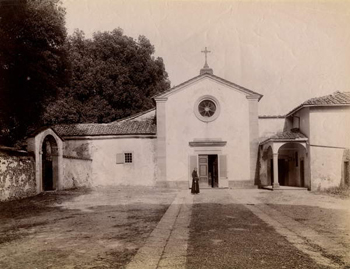
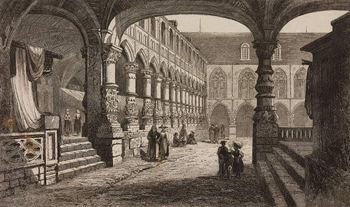 In the complete physiognomy of the Church – not in the disfigurations that Progressivism presents of her – we see, on one hand, the Pope as a Monarch more important than any monarch, surrounded by a fabulous pomp, in a palace that has works of art that no King of Europe or the East has; with an archive that no archive in the world can emulate. At his side he has a senate of Cardinals wearing red mantels, men who are illustrious under many titles, all with a great social standing. Here we see the Church. The Holy Spirit uses the things of this earth to give more strength to the Word of God.
In the complete physiognomy of the Church – not in the disfigurations that Progressivism presents of her – we see, on one hand, the Pope as a Monarch more important than any monarch, surrounded by a fabulous pomp, in a palace that has works of art that no King of Europe or the East has; with an archive that no archive in the world can emulate. At his side he has a senate of Cardinals wearing red mantels, men who are illustrious under many titles, all with a great social standing. Here we see the Church. The Holy Spirit uses the things of this earth to give more strength to the Word of God.
But, then, we see the opposite. The Capuchin has nothing of this magnificence; he renounced it all. We see the Holy Spirit using the renouncemnent of everything on this earth to give more strength to the Word of God.
It is a sort of double play of harmonic contrasts where we see the omnipotence of God and where we perceive the variety that exists in the Catholic Church. God speaks to all His creatures through these men: those who represent richness and those who represent poverty.
By means of one and another, He speaks words of love, audacity, dedication and braveness. Words that are especially important in our times where the ostriches are not only among the laity, but, unfortunately, are very frequently found among the clergy.
In his time St. Pius X used to say: De gentibus non est vir mecum, among all peoples there is no man with me. He meant that no one want to take up the fight and pursue it to its furthest point.
Today we can say the same thing: How few are those who actually defend the Church! Well then, we have the extraordinary figure of a man, the ideal Capuchin, who was always at the side of the Church in all her sorrows. It is the figure of the Capuchin with his poor habit, his beard, his tonsure, his frank word and his fiery gaze.
We know that S. Joseph Leonissa was a Capuchin who cooperated with grace to form in the firmament of the Church this profile of the Capuchin.
We do not need to say anything else. It suffices to beg him to pray for us. There are many things that we know about this anonymous Saint: He was Saint, he was a Capuchin.


The Saint of the Day features highlights from the lives of saints based on comments made by the late Prof. Plinio Corrêa de Oliveira. Following the example of St. John Bosco who used to make similar talks for the boys of his College, each evening it was Prof. Plinio’s custom to make a short commentary on the lives of the next day’s saint in a meeting for youth in order to encourage them in the practice of virtue and love for the Catholic Church. TIA thought that its readers could profit from these valuable commentaries.
The texts of both the biographical data and the comments come from personal notes taken by Atila S. Guimarães from 1964 to 1995. Given the fact that the source is a personal notebook, it is possible that at times the biographic notes transcribed here will not rigorously follow the original text read by Prof. Plinio. The commentaries have also been adapted and translated for TIA’s site.
He was a member of the Order of the Friars Minor Capuchin. His relic is venerated in our chapel. He lived in the 16th century.
Comments of Dr. Plinio:
Unfortunately I have no other biographical data on St. Joseph Leonissa. We received a theca with relics of all Capuchin Saints as a gift from Prof. Fernando Furquim, who brought it from Rome. Since we normally make a mention of the Saints whose relics are in our chapel, here is a reference to St. Joseph of Leonissa.

St Joseph of Leonissa, 1556-1612, known for his uncompromised preaching & austerity of life
Who was this Saint? What did he do during his life? In what way did he give glory to God?
Our answer is an act of faith. We know that he was a Saint and therefore he did excellent things. We do not know in which way he gave glory to God, even though we know that he gave glory to God since Holy Mother Church has declared him a Saint.
We only know one thing about St. Joseph of Leonissa from this brief selection, and it suffices: He was a Capuchin Saint.
What does it mean to be a Capuchin Saint? What are the traits that marked the Capuchins in History? What is the message for a Catholic soul when it learns that Joseph of Leonissa was a Capuchin Saint?
We know that the Franciscan Order is one of the major spiritual families born in the Church from the zeal of an incomparable man, St. Francis of Assisi. He had such a love for Our Lord that he acquired a physical similarity with Our Lord. If a person were to look at St. Francis he might think that he was seeing Our Lord.

Great Franciscan Saints in the New World gather under the mantle of Our Lady of Guadalupe
From this plurality of interpretations many branches were born within the Franciscan Order, approved by the Church. One of them was the Capuchin Order.
At the moment the spirit of St. Francis was weakened in other branches of the Franciscans, the Capuchin Order represented the radicalism of its poverty. It represented the radicalism of that great independence that only poverty gives.
Today one judges that only a wealthy man is independent. In the time that the Capuchins came into being, it was known that, with wealth came many concerns, attachments, duties and need for protection. Therefore, wealth attaches man to earth and poverty actually raises man above earthly concerns.
A poor man has fewer obligations, fewer goods to defend; he lives trusting Divine Providence. One who does not have anything has nothing to fear, so to speak. One who needs very little is the most independent man that exists. The Capuchin friar represented this independent man.
He was not independent regarding his superiors and the Catholic Church – to which he was bound by the vow of obedience – but he was independent regarding the powers of the world.
The Capuchin was by definition the audacious preacher who spoke the entire truth. He would speak the truth as a confessor and as a preacher to all the great men of this world, be they the great Prelates of the Church or the prestigious heads of the State.

A Capuchin preaching to the people
in a courtyard of Paris
He knew that he was a priest and a religious and, because of this, he was more than everyone. The fact that he spoke the truth to all made the Capuchin the type of célèbre preacher who was invited to preach in the courts. He ascended to the pulpit causing shockwaves by the poverty of his habit, by the rope he wore at the waist – his only ornament – which represented obedience since with it the superior could drag him wherever he desired.
He had a beard, at a time when elegant men had well-kept, refined and perfumed beards with delicate moustaches, the big spontaneous Capuchin had a shocky beard that covered his whole chest. His tonsure was prominent and disfigured his head, giving a jolt to the beauty of the well-groomed hair styles adopted by the hidalgos. All these characteristics represented his renouncement of everything to which people could be attached.
In the confessional the Capuchin was the direct, precise, crystalline confessor, unafraid to give severe penances, unmindful of what others would say about his rigor. He would spend hours in the confessional resolving the problems of persons. The Capuchin was the proper expression of the perfect confessor. A lion against the sin and a lamb toward the sinner, he would energetically rip the souls from the Devil's claws and lead them to Heaven.
This profile of the Capuchin entered History as one the riches of the Church, one of the splendors of the Church, one of the magnificent types through which the Holy Spirit makes His work.

A simple Capuchin Monastery in Tuscany; below, the Bishops' Palace in Liege, Belgium - The Church values both ways of life

But, then, we see the opposite. The Capuchin has nothing of this magnificence; he renounced it all. We see the Holy Spirit using the renouncemnent of everything on this earth to give more strength to the Word of God.
It is a sort of double play of harmonic contrasts where we see the omnipotence of God and where we perceive the variety that exists in the Catholic Church. God speaks to all His creatures through these men: those who represent richness and those who represent poverty.
By means of one and another, He speaks words of love, audacity, dedication and braveness. Words that are especially important in our times where the ostriches are not only among the laity, but, unfortunately, are very frequently found among the clergy.
In his time St. Pius X used to say: De gentibus non est vir mecum, among all peoples there is no man with me. He meant that no one want to take up the fight and pursue it to its furthest point.
Today we can say the same thing: How few are those who actually defend the Church! Well then, we have the extraordinary figure of a man, the ideal Capuchin, who was always at the side of the Church in all her sorrows. It is the figure of the Capuchin with his poor habit, his beard, his tonsure, his frank word and his fiery gaze.
We know that S. Joseph Leonissa was a Capuchin who cooperated with grace to form in the firmament of the Church this profile of the Capuchin.
We do not need to say anything else. It suffices to beg him to pray for us. There are many things that we know about this anonymous Saint: He was Saint, he was a Capuchin.

 | |
|
|
The texts of both the biographical data and the comments come from personal notes taken by Atila S. Guimarães from 1964 to 1995. Given the fact that the source is a personal notebook, it is possible that at times the biographic notes transcribed here will not rigorously follow the original text read by Prof. Plinio. The commentaries have also been adapted and translated for TIA’s site.


